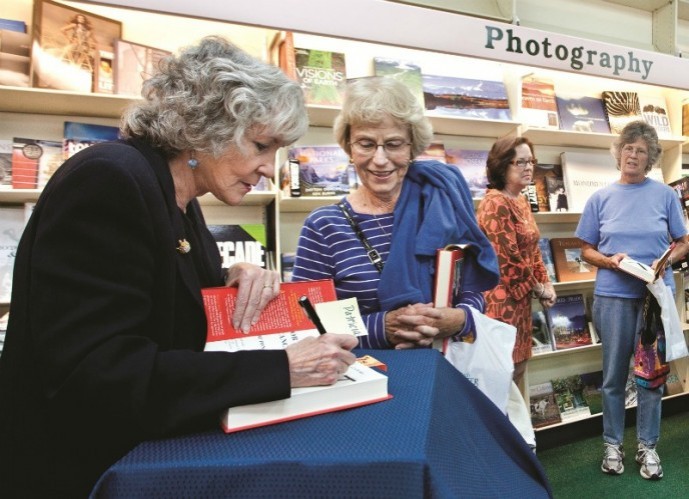VERO BEACH — When best-selling mystery author Sue Grafton spoke last week at the Moorings Literary Society luncheon, Moorings Club Chef Michael Lander honored her signature alphabet-themed titles with a demitasse of alphabet soup. For dessert, there was a chocolate cake with “V” in relief – for her latest book “V is for Vengeance.”
Over 150 people attended to hear about the latest novel and have books signed.
From there, Grafton headed to the Vero Beach Book Center, where 200 more people snaked through the aisles.
People came from Tampa, Sarasota, and Lakeland to have books signed.
Grafton was last in Vero in 1999, when “O is for Outlaw” was published.
Grafton regards her popular novels featuring female private investigator Kinsey Millhone as historical novels, though they are set in the 1980s.
“What’s dramatic isn’t always a good story or what is satisfying to the reader,” Grafton said in a telephone interview. “The technology isn’t as hard to keep track of as the ordinary life. What did we know then?”
Without access to the internet, Kinsey researches the old-fashioned way, going to the property clerk or the library; she puts each piece of information on a 3 x 5 index card.
“V is for Vengeance” blends dramatic elements into a satisfying read.
Millhone sees a woman shoplifting and notifies store personnel. Initially happy that the woman was charged and arrested, Millhone is appalled to see her obituary two days later.
Millhone feels responsible and wonders if the arrest triggered a heart attack; she quickly learns that the woman committed suicide.
Hired by the woman’s fiancé to investigate her life, Millhone sees several names repeat on her index cards.
Is something big at play? Is Millhone at risk?
Justice is served at the end of this complex story.
Grafton develops her novels in journals, exploring aspects of each new story.
“It’s interesting to look at the journal against the finished product,” she says. “It seems inevitable at the end, but it took trial and error to get there.”
Born and raised in Louisville, Ky., Grafton and her husband split their time between homes in Montecito, Calif., and Louisville.
An energetic 71, Grafton started writing at 18 and finished her first novel at 22.
She completed six more novels, publishing two non-series books.
For 15 years, she wrote screenplays for TV and movies.
Hard-boiled crime had been a male province until 1977, when Marcia Muller’s novel “Edwin of the Iron Shoes” introduced female investigator Sharon McCone.
“The male private investigator novel had gotten rigid and was becoming a parody,” says Grafton.
In 1982, Grafton and Sara Paretsky introduced their female sleuths Kinsey Millhone and V.I. Warshawski, “kicking down the doors” as Grafton puts it.
Grafton’s writing has received international honors.
In 2008, the U.K.’s Crime Writers Association presented her its Diamond Dagger award, recognizing “sustained excellence” in crime writing.
In 2009, The Mystery Writers of America honored her with the Grand Master award for lifetime achievement and consistent quality.
Talking about her awards, Grafton said she “gets a tear in her eye” and appreciates the recognition.
Paretsky has won the Diamond Dagger; Muller and Paretsky are also MWA Grand Masters. Muller is considered the founding mother of today’s hardboiled female private investigator.
All three women are New York Times best-selling authors with world-wide readerships in the millions.
“It’s nice to see women stepping to the fore,” says Grafton, adding that the awards show “the world appreciates the work we’ve done.”
Initially knowing nothing about private investigation, Grafton taught herself how private eyes work, and related subjects like police procedure and California criminal law.
“The only expertise I had was being female, and I didn’t want to give that up,” she says of creating her character Kinsey.
Grafton jokes that a tough divorce and custody battle gave her “homicidal urges” she channeled into her novel.
She eventually remarried, and her husband of 33 years, Steve Humphrey, teaches at University of California-Santa Barbara.
Stability and order are crucial to Grafton’s writing.
Seven days a week she is at her desk by 8:30 a.m.; she writes for five to six hours with a brief break for lunch.
Grafton says she can’t work in chaos, and doesn’t take a laptop with her on tour. When she returns home, Grafton will begin a new journal for the next book in the series.
“Touring to promote a book is a different skill set than writing,” she says. “Touring gives me breathing space.”

